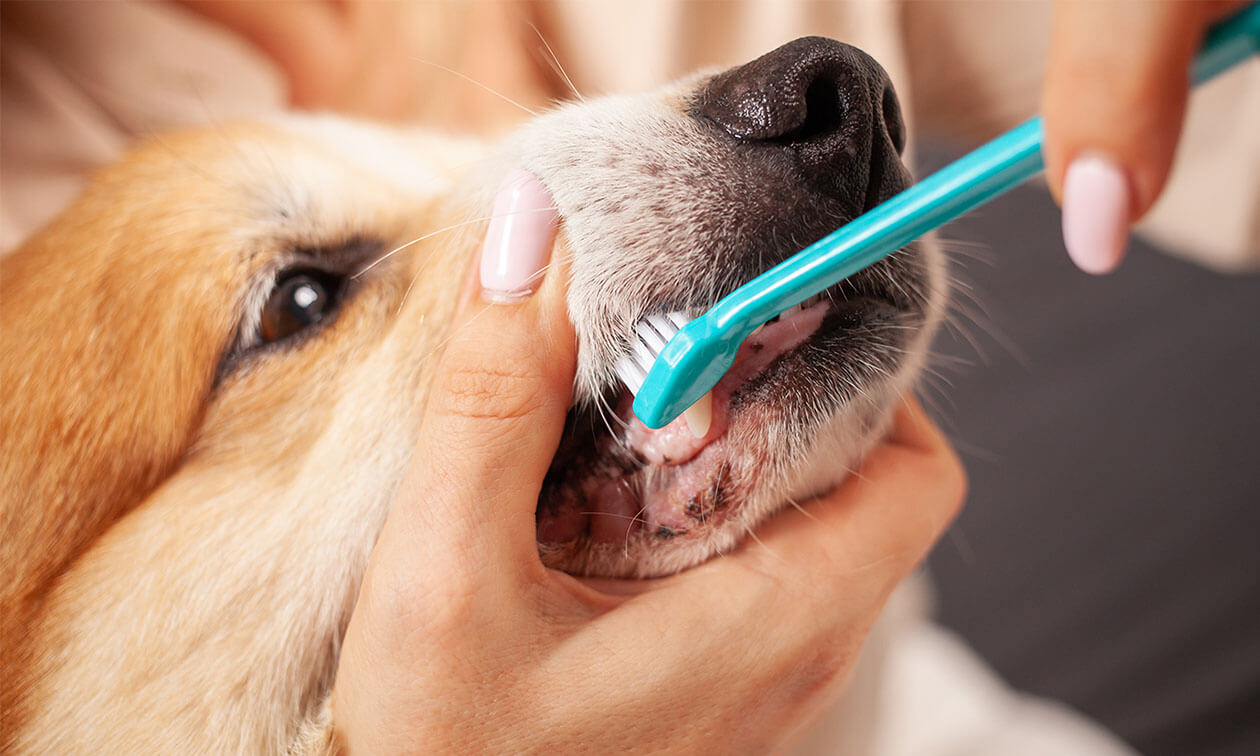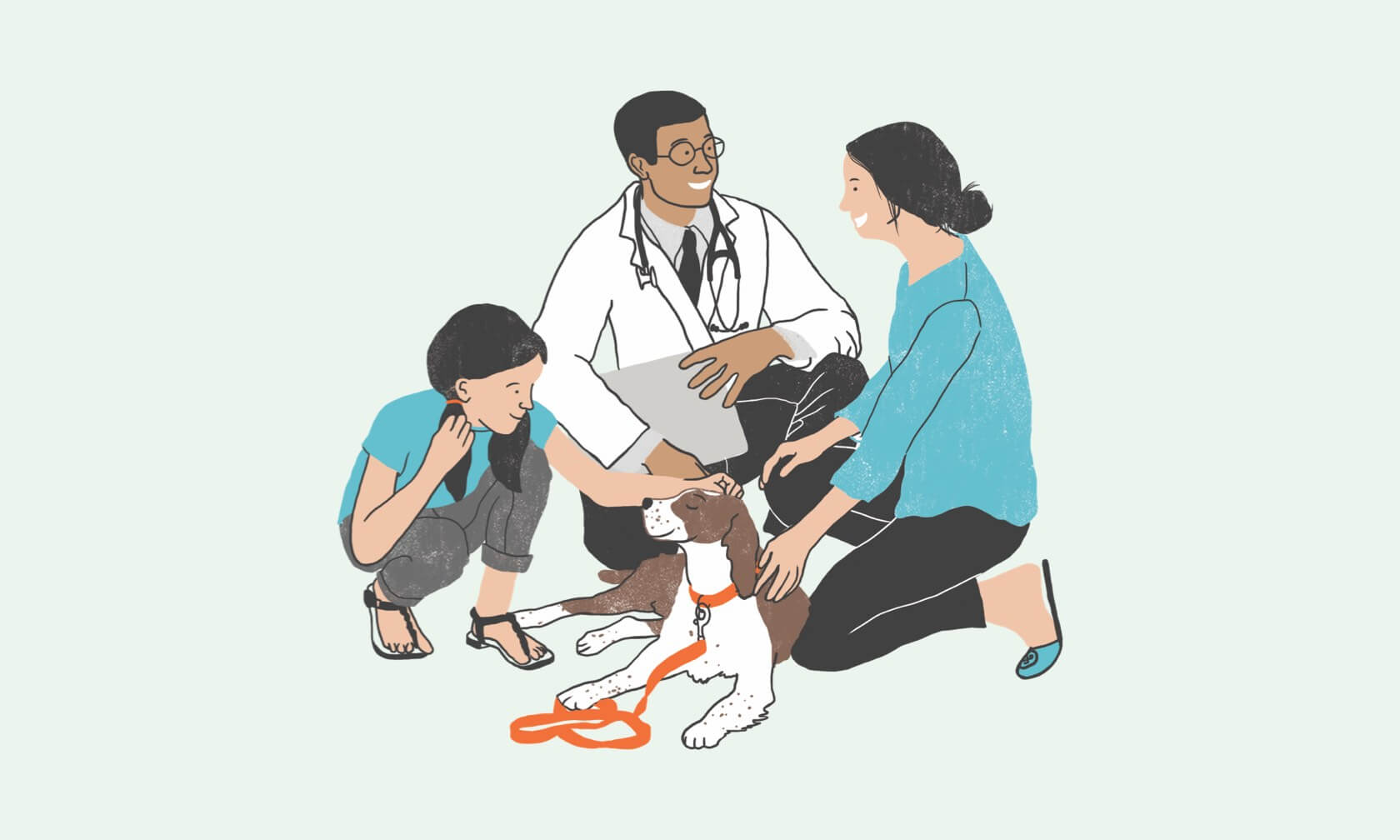How to Keep Your Dog's Teeth Clean
The thought of cleaning your dog's teeth can seem overwhelming, but dental health is an important part of dog ownership. In fact, at least 80% of dogs over three have periodontal disease (dental disease).1
The good news is that with a few tips and tricks, cleaning your dog’s teeth can be a simple and positive process that helps them avoid dental problems and live a longer, healthier life.
Keeping Your Dog’s Teeth Clean Prevents Disease
Without proper dental care, your dog can develop dental disease, which can lead to medical issues in the mouth and body. Mild cases can cause inflammation of the gums, which may cause significant pain for your dog. Severe cases can lead to tooth root abscesses, infection of the jawbone, and even jaw fractures.
Dental disease also increases bacteria in the mouth and oral tissues, which can enter the bloodstream. Once in the bloodstream, bacteria can travel to other parts of the body, such as the heart, liver, and kidneys, causing infection and inflammation. Such issues can shorten your dog's overall lifespan.
Prevention is key to preventing dental disease and includes measures like daily brushing and regular dental exams from your veterinarian.
Tools To Keep Your Dog's Teeth Clean
To keep your dog’s teeth clean and mouth healthy, there are some doggie dental tools you'll need.
Dog-Specific Toothpaste
Use an enzymatic toothpaste made for dogs. It should have a seal of acceptance by the Veterinary Oral Health Council (VOHC).
You should never use human toothpaste. It's not meant to be swallowed and may contain harmful ingredients such as xylitol, fluoride, sodium lauryl sulfate, and sodium (salt).
A Toothbrush
Choose one that suits the size of your dog's mouth and your experience level. A small, soft toothbrush is a good option for smaller dogs and those who don't like things in their mouth.
For larger dogs, try a toothbrush with an angled, long handle. A two-ended option with a small and large head is helpful for different-sized teeth. Be sure that it has soft bristles.
For beginners, using a finger brush may be better since you can feel the surface of the teeth more easily. However, this isn't recommended if your dog tends to bite when things are put near or in their mouth.
Cleanliness Between Brushings
There are also products you can use to help keep your dog's teeth clean between brushings. Choose products with a seal of acceptance from the Veterinary Oral Health Council or those recommended by your veterinarian.
Dental Treats and Dental Chews
Using positive reinforcement with treats will make dental care easier and more enjoyable for your dog. Choose dental treats and dental chews that match your dog’s weight and chewing style.
Oral Rinses, Gels, or Sprays
These products soften plaque and tartar as well as freshen breath. They contain active ingredients to kill bacteria and can get under the gumline to help stop buildup. They're generally very easy to use since they don't have to be applied on the tooth directly to work.
Water Additives
These products are put directly into your dog's drinking water. When they drink, the additive cleans the bacteria that can cause gingivitis and periodontal disease. Another benefit is fresher breath.
Be sure to only use dog-specific products that have been researched and accepted by the VOHC and do not contain harmful ingredients such as dyes, xylitol, or birch sugar. Talk to your veterinarian about proper introduction to water additives.
Food Additives
Dental food additives can help clean your dog's teeth as they eat. They reduce the formation of plaque, calculus, and tartar. Some contain probiotics that help maintain a healthy bacterial balance in your dog's mouth and remove plaque-causing bacteria.
Dental Diets
These diets are specifically formulated to be larger with a specialized texture that polishes the teeth when your dog chews, limiting the amount of plaque and tartar buildup.
The Training Process
Getting your dog comfortable with daily tooth brushing might take some time. Starting them when they’re young will help, but dogs of any age can learn to accept it If your dog is uncomfortable, keep each training session brief and positive.
Start by introducing your dog to the toothpaste. Most dogs are excited to sniff and taste dog-friendly toothpaste because it is a flavored, tasty treat. Let them sniff and investigate it, associating it with positive experiences such as treats or praise. Then introduce the toothbrush with toothpaste on it. This will help them form a positive association with the toothpaste and toothbrush.
Next, gently touch your dog's muzzle and slowly introduce your fingers into their mouth, mimicking the motion of brushing. Initially, you can use your finger with the dog toothpaste, then a finger brush or a soft cloth, to massage their gums and teeth. Praise and reward your dog with treats throughout this process to make it a positive experience.
As your dog becomes more relaxed, gradually transition to a dog toothbrush. Be patient and take breaks as needed. Remember to reward your dog after each successful brushing session.
How To Brush Your Dog's Teeth
When your dog is comfortable with the handling and products, it's time for regular brushing.
Holding the toothbrush at a slight angle and using light pressure, brush your dog's teeth from front to back or in a circular pattern. If you notice their gums becoming irritated or bleeding, you may be brushing too hard or a dental issue may be present. Talk to your vet to make sure you are on the right track with your at home dental care.
Try to brush in the same pattern each time. Focus predominately on the outer surface of the teeth, facing the cheeks/lips, at the gumline. Unless your dog is very comfortable and enjoys brushing their teeth, don't attempt to brush the inner surface of the teeth since this increases the chances of being accidentally bitten. Their tongue will help remove the plaque well enough that it isn't worth stressing them out or risking injury to you.
Think of your dog’s teeth in sections. The incisors are the front teeth, the canines are the pointed fang-like teeth, the premolars and molars, are the large chewing teeth located behind the canines. These sections are on the top and bottom as well as the left and right sides of your dog's mouth. Spend about five to ten seconds brushing each section.
Tips To Make Brushing Your Dog's Teeth Easier
Even with the right supplies and approach, some dogs need a little more help getting used to teeth brushing.
Do a Little Something Each Day
To be most effective, brush your dog's teeth daily since plaque begins to harden within 24 hours and then turns into tartar which is difficult to remove. If this isn't feasible, shoot for at least three times a week and add one or more of the products above to supplement teeth brushing.
Make It a Habit
Creating a routine will help your dog get used to the process more easily and help you make it a habit.
Pick Your Spot and Time
Ideally, you want to brush their teeth in the same location and at about the same time for every session. This helps build the routine and your dog's comfort. You want to choose a time and location that is quiet and free of distractions.
Stay Calm
Your dog takes cues from your body language. You need to be calm for them to be calm. To make this easier, brush their teeth when you aren't in a rush.
Don't Be a Perfectionist
To start, don't worry about how clean the teeth are getting. Just do what you can. Things will improve as you become more experienced and your dog more comfortable.
ZPC-04568
- Dog Owners’ Perspectives on Canine Dental Health – A Questionnaire Study in Sweden. National Library of Medicine. https://www.ncbi.nlm.nih.gov/pmc/articles/PMC7297050/. Accessed February 19, 2024.



